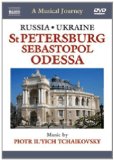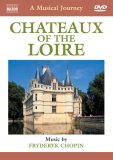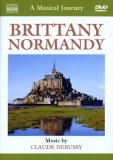 Musical Journey, A - Madrid, La Mancha, Toledo | DVD | (30/08/2004)
from £7.95
| Saving you £1.04 (11.60%)
| RRP
Musical Journey, A - Madrid, La Mancha, Toledo | DVD | (30/08/2004)
from £7.95
| Saving you £1.04 (11.60%)
| RRP Madrid . La Mancha . ToledoThe PlacesWe explore the streets palaces and parks of Madrid the capital of Castile and of Spain before turning south to La Mancha the country of the immortal Don Quixote and to Toledo the home of Cervantes and of the great painter known as El Greco.The MusicThe music of Spain held an exotic attraction for composers from other lands. The Russians Glinka and Rimsky-Korsakov found inspiration here as did the French composers Lalo Masse
![A Musical Journey: Italy, Switzerland, Southern Tyrol and Ticino [DVD] [2009]](/pictures/1131165.jpg) A Musical Journey: Italy, Switzerland, Southern Tyrol and Ticino | DVD | (27/04/2009)
from £7.95
| Saving you £1.04 (11.60%)
| RRP
A Musical Journey: Italy, Switzerland, Southern Tyrol and Ticino | DVD | (27/04/2009)
from £7.95
| Saving you £1.04 (11.60%)
| RRP New !!! Neuf !!! Neu !!! Nuovo !!! Nuevo !!!
 A Musical Journey - Moscow And The Golden Ring | DVD | (30/08/2004)
from £7.75
| Saving you £1.24 (13.80%)
| RRP
A Musical Journey - Moscow And The Golden Ring | DVD | (30/08/2004)
from £7.75
| Saving you £1.24 (13.80%)
| RRP Moscow and the Golden RingThe PlacesScenes from Moscow and the Golden Ring the cluster of historic towns to the north-east of the city including Vladimir Suzdal Rostov and Zagorsk show the historic heart of Russia in winter and summer.The MusicThe Music here included ranges from folk-song and extracts from the Russian Orthodox liturgy to works by Russian nationalist composers of the later nineteenth century including Balakirev Arensky and the more cosmop
![Mozart - a Musical Journey: Austria [2008]](/pictures/1085251.jpg) Mozart - a Musical Journey: Austria | DVD | (30/06/2008)
from £7.95
| Saving you £1.04 (11.60%)
| RRP
Mozart - a Musical Journey: Austria | DVD | (30/06/2008)
from £7.95
| Saving you £1.04 (11.60%)
| RRP Austria:This tour of Austria takes us from the historic towns of Stein-Krems and Salzburg to the former imperial country residence at Laxenburg, the Imperial Treasury in Vienna and the vivid contemporary architecture of Fritz Stowasser, better known as Hundertwasser.The music for this tour of Austria is taken from two concertos by Mozart, his clarinet concerto and his oboe concerto.
![Musical Journey: Germany [DVD] [2009]](/pictures/1095681.jpg) Musical Journey: Germany | DVD | (27/04/2009)
from £7.95
| Saving you £1.04 (11.60%)
| RRP
Musical Journey: Germany | DVD | (27/04/2009)
from £7.95
| Saving you £1.04 (11.60%)
| RRP Bruch / Weber: Musical Journey - Germany / Bavaria
![Northern Italy And Sicily (Mantua / Cremona / Etna) [DVD] [2010]](/pictures/1135767.jpg) Northern Italy And Sicily (Mantua / Cremona / Etna) | DVD | (30/11/2009)
from £15.42
| Saving you £-5.17 (N/A%)
| RRP
Northern Italy And Sicily (Mantua / Cremona / Etna) | DVD | (30/11/2009)
from £15.42
| Saving you £-5.17 (N/A%)
| RRP NAX 2110251; NAXOS - Germania; Classica in genere
![A Musical Journey: Bavaria (Bavaria/ Switzerland) [DVD] [2009]](/pictures/1135669.jpg) A Musical Journey: Bavaria (Bavaria/ Switzerland) | DVD | (26/10/2009)
from £15.85
| Saving you £-5.60 (N/A%)
| RRP
A Musical Journey: Bavaria (Bavaria/ Switzerland) | DVD | (26/10/2009)
from £15.85
| Saving you £-5.60 (N/A%)
| RRP The Places: The musical tour starts in the Bernese Alps, which offer some of the finest scenery in Switzerland, with glaciers and snow-covered expanses, and the towering Matterhorn. The Nymphenburg Palace and Park, near Munich, present a contrast, in their baroque elegance. The Music: Music for the tour is taken from Tchaikovsky's Piano Concerto No. 1 in B flat minor, one of the best known of all romantic concertos. This is followed by his Souvenir d'un lie.
![Musical Journey: France [DVD] [2009]](/pictures/1095682.jpg) Musical Journey: France | DVD | (27/04/2009)
from £7.19
| Saving you £1.80 (20.00%)
| RRP
Musical Journey: France | DVD | (27/04/2009)
from £7.19
| Saving you £1.80 (20.00%)
| RRP Chopin: Musical Journey - France
 Tchaikovsky - Russia and Ukraine: a Musical Journey | DVD | (28/07/2008)
from £8.99
| Saving you £N/A (N/A%)
| RRP
Tchaikovsky - Russia and Ukraine: a Musical Journey | DVD | (28/07/2008)
from £8.99
| Saving you £N/A (N/A%)
| RRP A Musical JourneyOur tour of Russia starts in St Petersburg, including churches and places, and , above all, the River Neva, on the banks of which Peter the Great's city stands. We visit Tchaikovsky's house at Klin, near Moscow, and travel south to Ukraine to see Sebastopol in the Crimea and Odessa. Finally we return to St Petersburg, seeing the surrounding countryside, the city by night, the bridges and the people.
 Chopin - a Musical Journey: Chateaux of the Loire | DVD | (30/10/2006)
from £16.55
| Saving you £-6.30 (N/A%)
| RRP
Chopin - a Musical Journey: Chateaux of the Loire | DVD | (30/10/2006)
from £16.55
| Saving you £-6.30 (N/A%)
| RRP The PlacesThe great chateaux and country houses of the Loire arose largely from the decision of Francois I, who came to the throne in 1515, to move his court for part of the year to the Loire valley. This coincided with a period of French architecture in which the Italian Renaissance style was notably influential, often combined with the existing Gothic. An extraordinarily large number of imposing chateaux resulted, from Chombord and Blois to Azay-le-Rideau.The musicThe music accompanying this tour of the Loire is all by Fryderyk Chopin. Born in Poland of a Polish mother and emigre French father, Chopin settled in Paris and his liaison with the writer George Sand (Aurore Dudevant) allowed him generally to spend summer months with her at her Chateau de Nohant in the upper valley of the Indre, the so-called Black Valley. The music chosen here is taken from his many Waltzes, a popular dance that he elevated from the ball-room to the concert salon.
![Handel - a Musical Journey: England [2008]](/pictures/1085250.jpg) Handel - a Musical Journey: England | DVD | (30/06/2008)
from £11.11
| Saving you £-2.12 (-23.60%)
| RRP
Handel - a Musical Journey: England | DVD | (30/06/2008)
from £11.11
| Saving you £-2.12 (-23.60%)
| RRP Our tour takes us to three great English houses. The first, near Oxford, is Blenheim Palace, built for the first Duke of Marloborough by Sir John Vanbrugh. The second is the romantic Leeds Castle Howard in North Yorkshire, designed for the Howard family by Vanbrugh.The music chosen to accompany out tour is by George Frideric Handel, who finally settled in England in 1712, assuming a dominant position in English music. Hos Water Music was written to entertain King George I, probably in 1717, as he sailed up the Thames, and the second, the Music For The Royal Fireworks was commissioned to celebrate the Peace of Aix-La-Chapelle in 1749, accompanying a firework display in Green Park.
![A Chinese Musical Journey - Xi'an [2007]](/pictures/1080220.jpg) A Chinese Musical Journey - Xi'an | DVD | (29/10/2007)
from £8.95
| Saving you £0.04 (0.40%)
| RRP
A Chinese Musical Journey - Xi'an | DVD | (29/10/2007)
from £8.95
| Saving you £0.04 (0.40%)
| RRP The capital of Shaanxi Province, Xi'an, its name translating as 'Western Peace', was the Chinese capital during the Tang dynasty (618-906 A.D). The Big Wild Goose Pagoda, completed in 704 on the orders of the Empress Wu Zetian during her period of rule as Empress of the Zhou dynasty, soon replaced by the restored Tang, is one of the oldest such structures in China. Of particular interest is the tomb of the Emperor Huang, regarded as the founder of the unified Chinese nation, and the remarkable terracotta warriors and horses discovered around the mausoleum of Qin Shi Huang Di, founder of the Qin dynasty, who died in 210 B.C.. The tour ends with views of the precipitous Huashan (Flower Mountain), so called from its five peaks, grouped in the shape of a great flower.
![A Chinese Musical Journey - Hangzhou [2007]](/pictures/1080216.jpg) A Chinese Musical Journey - Hangzhou | DVD | (29/10/2007)
from £7.95
| Saving you £1.04 (11.60%)
| RRP
A Chinese Musical Journey - Hangzhou | DVD | (29/10/2007)
from £7.95
| Saving you £1.04 (11.60%)
| RRP A cultural tour of Hangzhou, capital of China's Zhejiang Province, with traditional Chinese music.
![Musical Journey: Spain [DVD] [2009]](/pictures/1095684.jpg) Musical Journey: Spain | DVD | (27/04/2009)
from £8.95
| Saving you £0.04 (0.40%)
| RRP
Musical Journey: Spain | DVD | (27/04/2009)
from £8.95
| Saving you £0.04 (0.40%)
| RRP Lalo / Saint-Saens / Sarasate: Musical Journey - Spain
 Debussy - a Musical Journey: Brittany and Normandy | DVD | (30/10/2006)
from £8.95
| Saving you £0.04 (0.40%)
| RRP
Debussy - a Musical Journey: Brittany and Normandy | DVD | (30/10/2006)
from £8.95
| Saving you £0.04 (0.40%)
| RRP The placesBrittany and Normandy, one Celtic in origin, culture and language, the other taking its name from the conquering Norsemen, have an enchantment all their own. The landscape, tinged by the magic of history, the ancient buildings and, above all, the sea, combine to offer an unforgettable panorama of the two regions.The musicThe French composer Claude Debussy suggested new paths for the future, introducing innovations in harmony, structure and orchestral colouring, the last often with a large orchestra delicately used. The music used here includes the evocative Prelude a l'apresmidi d'un faune, later transformed into a ballet by Nijinsky, the three Nocturnes, orchestral pieces that again suggest the beauty and variety of the landscapes and views of the sea that they here accompany, and finally La mer, in all its changes from dawn to dusk.
![Bach - a Musical Journey: Germany [2008]](/pictures/1085260.jpg) Bach - a Musical Journey: Germany | DVD | (30/06/2008)
from £7.95
| Saving you £1.04 (11.60%)
| RRP
Bach - a Musical Journey: Germany | DVD | (30/06/2008)
from £7.95
| Saving you £1.04 (11.60%)
| RRP ![Rimsky-Korsakov - a Musical Journey: Uzbekistan [2008]](/pictures/1085252.jpg) Rimsky-Korsakov - a Musical Journey: Uzbekistan | DVD | (30/06/2008)
from £7.95
| Saving you £1.04 (11.60%)
| RRP
Rimsky-Korsakov - a Musical Journey: Uzbekistan | DVD | (30/06/2008)
from £7.95
| Saving you £1.04 (11.60%)
| RRP Uzbekistan- A musical tour of the country's past and present- The places and the music.
![Musical Journey: Russia [DVD] [2009]](/pictures/1095683.jpg) Musical Journey: Russia | DVD | (27/04/2009)
from £7.95
| Saving you £1.04 (11.60%)
| RRP
Musical Journey: Russia | DVD | (27/04/2009)
from £7.95
| Saving you £1.04 (11.60%)
| RRP Tchaikovsky: Musical Journey - Russia
![A Chinese Musical Journey - Beijing [2007]](/pictures/1080224.jpg) A Chinese Musical Journey - Beijing | DVD | (29/10/2007)
from £7.95
| Saving you £1.04 (11.60%)
| RRP
A Chinese Musical Journey - Beijing | DVD | (29/10/2007)
from £7.95
| Saving you £1.04 (11.60%)
| RRP Beijing (Peking), the capital of China, has been the site of various cities with different names. Under Kubla Khan, who established the Mongolian Yuan dynasty (1279-1368), a new city, Khanbalik (Cambaluc) was built, to be destroyed by the Ming Emperors, the second of whom made Beijing once again the capital. Many of the historical remains come from the period of the Ming dynasty (1368-1644), and the following Qing (1644-1911). These include the former imperial palace, known as the Forbidden City, and other places, parks and dwellings. The Great Wall is represented by the well known sight of the Jinshanling section of this ancient structure, built during the early years of the Ming dynasty.
![A Chinese Musical Journey - Shanghai [2007]](/pictures/1080043.jpg) A Chinese Musical Journey - Shanghai | DVD | (29/10/2007)
from £14.59
| Saving you £-4.34 (N/A%)
| RRP
A Chinese Musical Journey - Shanghai | DVD | (29/10/2007)
from £14.59
| Saving you £-4.34 (N/A%)
| RRP The Places:The city of Shanghai, China's most important port, owes some of its prosperity to the so-called unequal treaties forced on China during the 19th century. The place had its origin as a settlement during the Tang dynasty (618-906 A.D.), but the Treaty of Nanking in 1842 ceded Hong Kong to the British and made possible the development of foreign trade through the five 'treaty ports', of which Shanghai became the most important. The growth of Shanghai into an international trading centre and the concessions made to various foreign countries explain the interesting mixture of architectural styles, continued today with the high-rise buildings of recent years.The Music:The music chosen for this tour of Shanghai is played on traditional Chinese instruments. Performing the music are the wind and string ensembles known as 'silk and bamboo', from their silk strings and bamboo pipes, and ensembles that also include percussion. Instruments given prominence include the dizi, heard first in Moonlight Autumn Night by the Lake, a transverse bamboo flute, and the yangqin, a Chinese dulcimer whose strings are struck with two bamboo sticks. Traditional Chinese music, like Chinese painting, is largely representational, its character indicated in its titles, although these may sometimes be drawn from opera or from poems.

Please wait. Loading...
This site uses cookies.
More details in our privacy policy